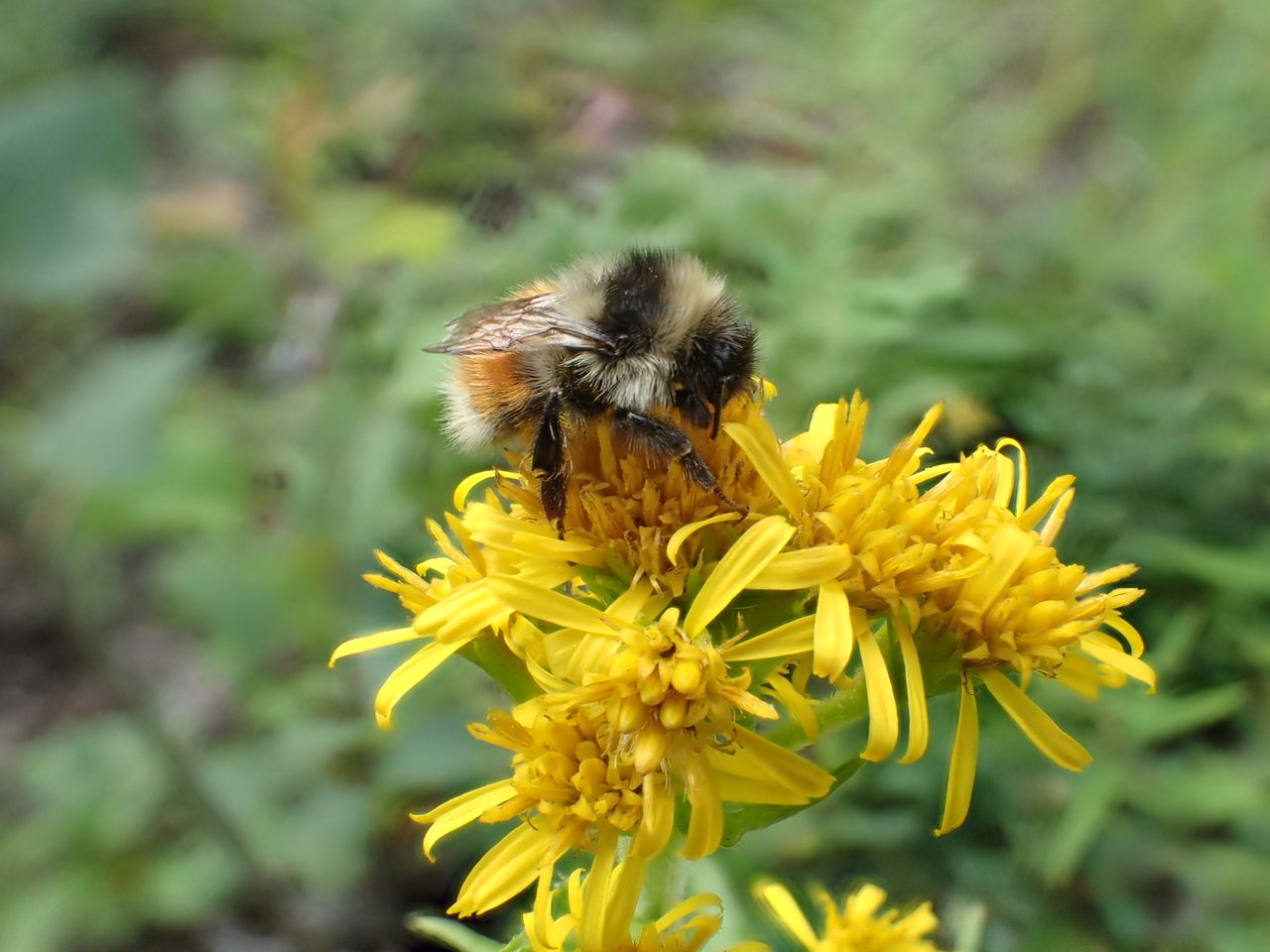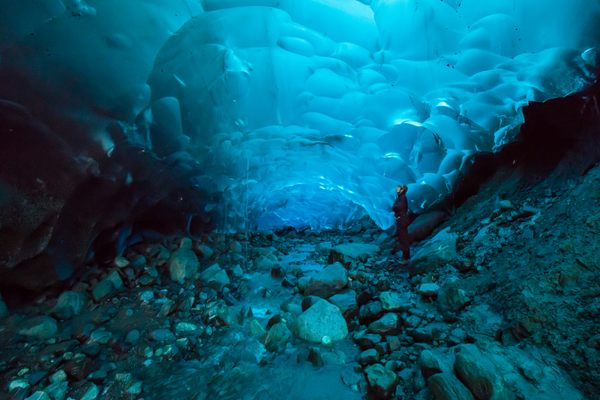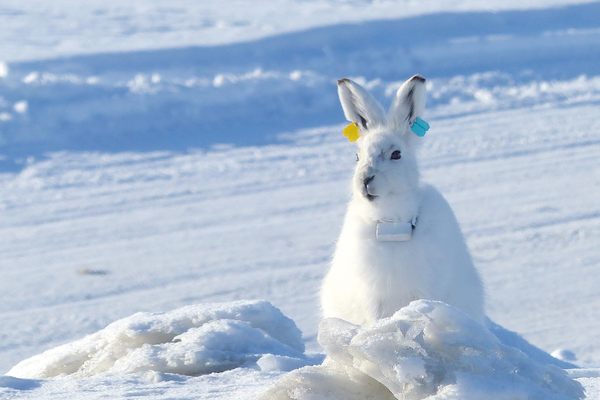What’s Up With Alaska’s Wild, Wondrous, ‘Warm-Blooded’ Bumblebees?
Extreme environments offer them an unexpected paradise, and now researchers want to get a head count.
“People don’t come to Denali and other parks in Alaska to look at bumblebees, but they should,” says Jessica Rykken, entomologist for Denali National Park and Preserve. The “Last Frontier” state may be known for supersized wildlife, from bears to moose, but on a smaller scale, the diversity of bumblebees (or bumble bees, depending on whom you ask) there is unusually high, and powers entire ecosystems.
“Bringing in that next generation of plants to provide habitat for caribou or moose or any large herbivore, and then the carnivores that depend on them, that’s all tied to pollinators,” says wildlife biologist Casey Burns, with the Bureau of Land Management in Alaska. “Arguably, I think they are the most important wildlife group for ecological function.”
Bumblebees are not the only native pollinators in the northernmost U.S. state. There are scores of other native bee species, and native flies also play a significant role (as do several butterfly species). But Alaska’s bumblebees stand out both in numbers—“We have, overall, fairly low diversity of bees, but we have a very high proportion of bumblebees,” says Rykken—and in the reasons for their success. And while many bumblebee species in the Lower 48 are declining, Alaska members of the genus Bombus appear to be thriving. Now, researchers and conservationists are embarking on an unprecedented effort to figure out just how many bees, including bumbles, are buzzing around their enormous and largely unsurveyed state. The first-ever Alaska bee atlas project is underway, and bumblebees will play a starring role.

Of the nearly 50 bumblebee species documented throughout the United States, almost half can be found in Alaska, including four species found nowhere else in the country. Big-bodied and covered in thick, insulating hair (on a Zoom call, Rykken holds up a board of fat, furry, pinned specimens, some the size of her thumb), the bumbles have other cold weather survival skills, including, well, twerking. While bees in general can rapidly vibrate their flight muscles, independent of flying, to generate warmth, bumblebees are particularly good at it.
“They use those flight muscles to raise their body temperature 30 degrees in five minutes,” says Rykken. That rapid rise in heat allows them to fly on cold, even snowy days, when other insects are grounded. And, while other social bees, including honeybees, will cluster to keep their queen, brood, and each other warm, bumblebees can survive solo. A Bombus queen can actually transfer the heat generated with its flight muscles into its abdomen to keep its eggs warm.
“They thermoregulate quite amazingly,” says entomologist Derek Sikes, curator of the insect collection at the University of Alaska Museum. Sikes says bumblebees are “actually warm-blooded: They generate heat, it’s just not constant, the way mammals do. But it is internal, not just from basking in the sun.”

The natural lifecycle of Bombus species fits with Alaska’s long winters and short summers. In August, when the first frosts typically arrive, the queen starts a long hibernation underground, alone. It emerges in spring, finds a nest site, and produces female worker bees and, eventually, potential new queens and males to mate with them. As August approaches again, successfully mated, new queens will find a spot to lie low during winter. “Everybody else—the old queen, the workers, the males—dies,” says Rykken. While many other social bee species overwinter in clusters of thousands, the bumblebees’ solo strategy requires fewer resources and is more efficient for their environment.
Five Alaska bumblebee species live in places that are extreme even by Alaska standards. “They’re very restricted to tundra habitats. You won’t even find them in southern Alaska,” says Rykken. As its name suggests, for example, B. polaris—the Arctic bumblebee—lives above the Arctic Circle. During the region’s brief summer, it’s often seen sitting on poppies, not to collect pollen, but to take advantage of the extra heat offered by the flower’s shape, which reflects sunlight. The parasitic B. hyperboreus, the high Arctic bumblebee, shares territory with B. polaris, perhaps much to the latter’s dismay. Lone B. hyperboreus queens emerge in spring, invade B. polaris nests, kill their queens, and then force the workers to raise their brood. Or, as a species description from the University of Guelph puts it: “B. hyperboreus is a bully, thief, and murderer.”

The high Arctic bee, often called “The Usurper,” is one of several parasitic bumblebee species present in Alaska. “When I go do bee surveys, I like to see parasitic species,” Rykken says. “It means that there is a host population to sustain them. They’re kind of a good indicator for the whole bee community that things are going pretty well.”
Alaska bumblebees seem to be doing well even where mosquitoes—the state’s infamously oversized, aggressive, and widespread winged terrors—fear to fly. “People often think the Arctic, the North Slope of Alaska, has got to be the coldest, harshest place, but it’s actually worse in the Aleutians,” says Sikes, referring to the arc of wind-battered and sea-lashed volcanic islands off Alaska’s southwest coast. “There are tons of mosquitoes in the Arctic, and almost none in the Aleutians. But there are bumblebees.” Sikes adds: “They’re pushing the envelope of what is possible for an insect.”
Alaska’s bumblebees continue to push that envelope, not only in where they live, but also in how many of them there are. Rykken conducts regular pollinator surveys within Denali Park and Preserve, home to at least 16 Bombus species. Her 2012 sampling helped lead to the discovery of B. kluanensis. The bumblebee closely resembles B. neoboreus, also found in Denali, but was identified as a new species through DNA analysis. It’s the first new bumblebee species from the United States or Canada to be described in nearly a century. It may not be the last. “In Alaska, we’re still very much in an age of discovery. We’re just figuring out what species we have here,” she says.
The goal of the planned bee atlas is to provide a baseline understanding of the pollinators’ distribution and diversity across Alaska, a massive undertaking given the state’s size, topography, and remoteness. Burns, one of the project’s leaders, says it’s a step toward developing a responsible management and conservation plan not just for the pollinators, but for the diverse landscapes they serve and call home. Right now, he says, “It’s difficult for us to manage what we don’t know.”
The initial phase of the bee atlas survey, trialed in 2020 and rolling out more widely this summer, is all about “opportunistic” sampling. Scientists heading out on various unrelated fieldwork assignments will take equipment to collect bumblebees and other bee species. The gear is lightweight and easy to use: plastic “bee bowls,” or pan traps, in bright yellow, red, and white, and taller blue vane traps, which look—to bumblebees, anyway—like large flowers. Burns has trained about 50 field-bound scientists so far on how to use the traps, as well as in the third collection method, aerial netting. The idea is to piggyback on field research without incurring additional expense, and to sample parts of the state not accessible via Alaska’s limited road network.

“They’re going out to the field already, and that’s the big expense, the aviation, getting people from Point A to Point B,” says Burns, as he snaps together pieces of blue plastic—the front of a blue vane trap—to create something vaguely resembling a giant, abstracted bluebell. “A helicopter drops you off, and you set up your traps for 24 hours and then go do your plant survey or whatever and come back and collect the traps.” He grins and adds: “It feels like the middle of nowhere and it kind of is. There are bears and all sorts of exciting, distracting things around. I’ve worked in California and Utah and there’s some real exciting species there, but nothing compares to being out doing that in Alaska.”
Alaska is not the first or only state to embark on an ambitious bee survey. In addition to a national bee atlas, still in its earliest planning stages, several states have launched their own projects. One of the furthest along, in Oregon, has its roots in tragedy: a cluster of bumblebee kills linked to pesticide use wiped out tens of thousands of the insects in 2013. Entomologists and science communicators needed effective ways to educate the public about the pollinators’ value, as well as ways to measure whether they were achieving their outreach goals. Born out of the earlier Oregon Bee Project, the atlas program there now allows non-scientists to log which bees they see, when, and where, similar to long-running bird surveys.
Oregon State University’s Andony Melathopoulos leads the bee atlas effort, and has some advice for his Alaska colleagues. “I imagine Alaska and Oregon are the same: There are people in the state who fear the listing of bee species. Oregon has the legacy of the spotted owl,” Melathopoulos says, referencing a controversy in the 1990s that pitted logging communities against conservationists. He says people from ranching, farming, and other land-use communities need to be involved in bee atlas initiatives from the start. “I know some of the data may have impacts on land management and I don’t want those people cut out. They should be there, and fluent in what’s going on.”
It’s something Burns and other team members in Alaska are already thinking about. Working for the Bureau of Land Management, the country’s largest land manager, comes with many stakeholders, says Burns, “We have to find a balance on a landscape scale… You can’t just go in and say, ‘We’re going to conserve all of this.’”

Having a bumblebee baseline in Alaska is particularly important now. While Alaska bumblebees are not threatened by habitat fragmentation, extensive agricultural pesticide use, or many of the other hazards faced by their kin in the Lower 48, climate change is “something we’re thinking about all the time,” says Rykken. “Habitat boundaries are shifting. Trees are moving upslope and northwards, and shrubs are encroaching into the tundra, so those tundra specialists potentially are losing habitat.”
Sikes echoes those concerns. A 2015 study he coauthored in Science, examining a century-plus of observations across North America and Europe, found that bumblebees across both continents were moving to higher elevations or disappearing from the southern part of their ranges as the planet warms. “Bumblebees are not very good with the heat,” says Sikes. “So climate change is a definite and obvious problem for them. And it may be one of the reasons why we’re seeing some of the bumblebees declining in the Lower 48.”

Oregon is “experiencing the same problems as in most of the Lower 48,” Melathopoulos says. “The bees in Bombus are in trouble.” B. franklini has not been seen in Oregon in years, he says, while other species have retreated to high-elevation pockets of their historic ranges. Alaska may offer some hope, however. Observations of B. occidentalis, the western bumblebee, have declined in the Lower 48, but it’s one of the most common in Alaska.
Jon Koch, a biologist and bumblebee expert with the U.S. Department of Agriculture in Logan, Utah, looked at B. occidentalis population estimates nationwide about a decade ago. He found that the western bumblebee had “significantly declined relative to historic estimates” in the Lower 48, but that, in Alaska, it was “relatively stable, and relatively abundant.” He believes that the new bee atlas may reveal Alaska is even more of a bumblebee paradise than we thought: “I wouldn’t be surprised if they identify even more species.”






























Follow us on Twitter to get the latest on the world's hidden wonders.
Like us on Facebook to get the latest on the world's hidden wonders.
Follow us on Twitter Like us on Facebook